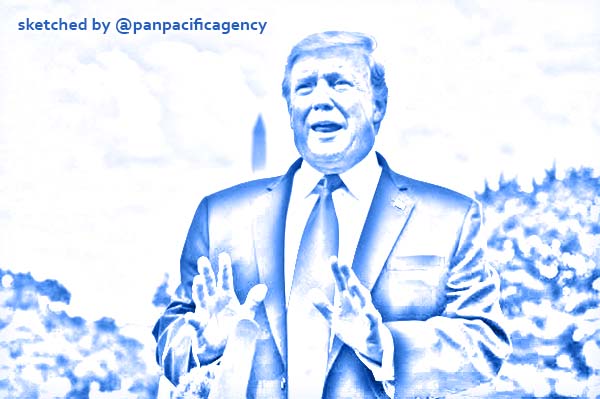[Analytics] “Five nuclear facilities” in North Korea according Donald Trump

US President Donald Trump talks to reporters in front of the White House before departing for a campaign rally in Mountoursville, Pennslylvania, on May 20 (Hankyoreh). Sketched by the Pan Pacific Agency.
On May 19, US President Donald Trump mentioned that there are five nuclear facilities in North Korea, raising the question about what facilities he was talking about other than the Yongbyon nuclear complex. Kim Ji-eun specially for the Hankyoreh.
While describing the situation at the North Korea-US summit in Hanoi this past February during an interview with Fox News on May 19, Trump said, “When I left Vietnam where we had the summit, I said to Chairman Kim [. . .] ‘Look you’re not ready for a deal,’ because he wanted to get rid of one or two [nuclear] sites, but he has five sites.” Trump’s remark implies that Kim was only planning to shut down a couple of nuclear facilities in North Korea out of a total of five.
“I say, ‘What about the other three sites? That’s no good — if we’re going to make a deal, let’s make a real deal,’” Trump also related.
During his interview, Trump didn’t specify the location of North Korea’s five nuclear facilities. But the “one or two sites” that he mentioned are probably the Yongbyon nuclear complex and the nuclear test site at Punggye Village. These are nuclear sites that North Korea has officially acknowledged, and Kim has expressed his willingness to shut down one and open the other to inspections.
One of the other nuclear facilities mentioned by Trump could be Kangson, where the US claims a secret uranium enrichment facility is located. While nuclear reactors are difficult to conceal because of their requisite cooling tower, uranium enrichment facilities can be operated underground without any definite giveaway.
Trump also said the US had discovered previously undisclosed North Korean nuclear facilities during his press conference immediately after the breakdown of talks in the North Korea-US summit. When reporters asked whether he was talking about the uranium enrichment facility, Trump said he was.
For now, experts don’t appear to be placing too much importance on Trump’s use of the number five. Instead, they stress that his remarks imply there are other nuclear facilities aside from Yongbyon.
“There’s no way to know the location of the five sites mentioned by President Trump. He could have been referring to a complex like Yongbyon,” said Ahn Jin-su, former head of research at the Korea Institute of Nuclear Nonproliferation and Control.
Other than Yongbyon, the major nuclear facilities that have been confirmed to exist in North Korea are mines and refineries: there are uranium mines in Pyongsan and Sunchon and a uranium refinery in Pyongsan. A uranium refinery in Bakchon reportedly ceased operations in 1992. Construction on a 200Mw graphite-moderated reactor in Taechon, North Pyongan Province, has apparently been halted. In addition, experts have said that other facilities could be widely dispersed, including nuclear weapon laboratories, high explosive testing sites, nuclear weapon repositories, uranium enrichment laboratories, and uranium enrichment facilities.
In connection with this, a VOA report on May 21 quoted Olli Heinonen, a former deputy director-general at the International Atomic Energy Agency (IAEA), as saying that the basic formula for operating a nuclear weapon development program implies that North Korea has at least five nuclear facilities. In addition to the Yongbyon nuclear complex and the nuclear test site at Punggye Village, Heinonen said, there would also technically have to be a plutonium conversion facility, a uranium enrichment facility, and a uranium hexafluorides conversion facility. There isn’t any definite information about where those facilities might be located.
Possibility of sixth facility
Cheryl Rofer, a former researcher at the Los Alamos National Laboratory, mentioned the possibility of a sixth facility directly related to nuclear weapon development, in addition to the five mentioned above.
“In a nuclear weapon you have conventional explosive to bring the fissile materials quickly. So there needs to be a place where those explosives are manufactured,” she said.
“In 2010, North Korea also had a [nuclear] site at Sowiri, which is near Yongbyon, that processes even more HEU [highly enriched uranium] than Yongbyon,” VOA quoted Bruce Bechtol, a professor at Angelo State University, as saying. Bechtol used to work for the US Defense Intelligence Agency.
During the second North Korea-US summit in Hanoi in February, Trump reportedly gave Kim a list of the North Korean nuclear facilities that the US has identified. “I understand that Kangson wasn’t the only facility on that list. What’s more important than the number [mentioned by Trump] is the fact that information that wasn’t reported to Kim during the working-level talks was conveyed to him at Hanoi,” said Lee Chun-geun, a senior analyst at the Science & Technology Policy Institute.